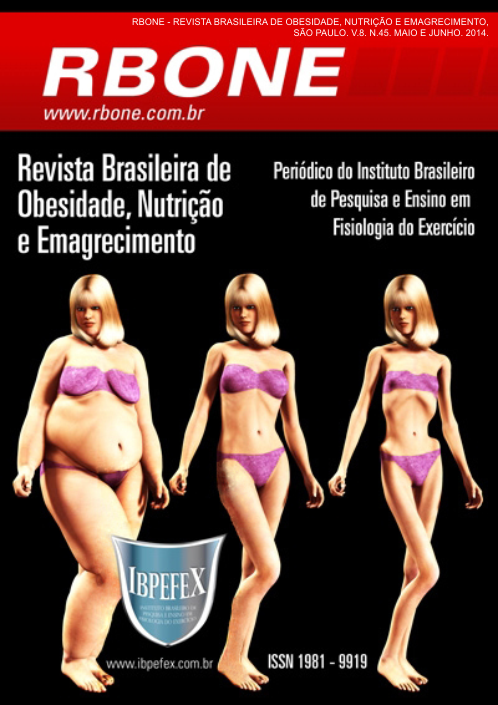Intragastric balloon: evolution of a multidisciplinary clinical treatment in weight loss and waist circumference
Abstract
Obesity is a multifactorial disease with high prevalence and alarming epidemic character, becoming one of the major public health problems nowadays. The technique of intragastric balloon (BIB) is ideal for patients with 40 % of overweight and whose previous clinical treatments have failed, even with a multidisciplinary approach. The aim was to evaluate weight loss and waist circumference after the first, third and sixth month of treatment with BIB and multidisciplinary team. The study was retrospective, collecting information in the database and records of private clinics. Entered in this analysis just patients who already completed 6 months of treatment. Weight, BMI and waist circumferencebefore commissioning and during the treatment of 31 patients were evaluated. The average weight "pre BIB " was 110.5 kg, BMI 39.7 kg / m². After 1 month of treatment, a reduction to 100.7 kg and 39.7 kg / m². After 3 months, the numbers decreased to 95.1 kg and 34.2 kg / m². At the end of six months, the development has proved very favorable with 89.9 kg and 32.3 kg / m². The results for the abdominal circumference were also considered satisfactory, 120.1, 113.4, 107.9, 102.1, respectively, representing the evolution pre 1 month, 3 months and 6 months of treatment. The use of the BIB, associated with the multidisciplinary treatment team specialist in the treatment of patients with this profile, promotes reduction in weight and waist circumference, due to the change in eating habits and inclusion of regular physical activity.
References
-Dastis, N.S.; François, E.; Deviere, J.; Hittelet, A.; Ilah Mehdi, A.; Barea, M.;Dumonceau, J.M. Intragastric balloon for weight loss: resultsin 100 individuals followed for at least 2.5 years. Endoscopy. Vol. 41. 2009. p. 575-580.
-Doldi, S.B.; Micheletto, G.; Di Prisco, F.; Zappa, M.A.; Lattuada, E.; Reitano, M. Intragastric Balloon in Obese Patients.Obesity Surgery. Vol. 10. 2000. p. 578-581.
-Doldi, S.B.; Micheletto, G.; Perrini, M.N.; Rapetti, R. Intragastric balloon: another option for treatment of obesity and morbid obesity. Hepato gastroenterology. Vol. 51. Num. 55. 2004. p. 294-297.
-Dumonceau, J. M. Evidence-based review of the Bioenterics intragastric balloon for weight loss. Obesity Surgery. Vol. 18. Num. 12. 2008. p. 1611-7.
-Flegal, K.M.; Carroll, M.D.; Ogden, C.L.; Curtin, L.R. Prevalence and trends in obesity among US adults, 1999-2008. Journal of the American Medical Association. Vol. 303. Num. 3. 2010. p. 235-41.
-Instituto Brasileiro de Geografia e Estatística. Pesquisa de Orçamentos Familiares 2008-2009. Rio de Janeiro. 2010.
-Pêgo-Fernandes, P.M.; Bibas, B.J.; Deboni, M. Obesity: the greatest epidemic of the 21st century? Medical Journal. Vol. 129. Num. 5. 2011. p. 283-284.
-Pinto, M.A.F. Análise da segurança e da efetividade do balão intragástrico em pacientes com obesidade: Revisão sistemática e metanálise. Tese de doutorado. Universidade Federal de São Paulo. São Paulo. 2007.
-Sallet, J.A.; Marchesini, J.B.; Paiva, D.S.; Komoto, K.; Pizani, C.E.; Ribeiro, M.L.; Miguel, P.; Ferraz, A.M.; Sallet, P.C. Brazilian multicentric study of the intragastric balloon. Obesity Surgery. Vol. 14. 2004. p. 991-994.
-Sallet, J.A.; Silva, M.A.; Miguel, P.; Marchesini, J.B. Balão Intragástrico: Segurança e Eficácia no Tratamento da Obesidade. ABESO. Vol. 58. 2012. p. 6-7.
-World Health Organization. World health statistics 2012. 2012.
-Yanovski, S.Z.; Yanovski, J.A. Obesity prevalence in the United States -up, down, or sideways? New England Journal of Medicine. Vol. 364. Num. 11. 2011. p. 987-989.
Authors who publish in this journal agree to the following terms:
- Authors retain the copyright and grant the journal the right of first publication, with work simultaneously licensed under the Creative Commons Attribution License BY-NC which allows the sharing of the work with acknowledgment of the authorship of the work and initial publication in this journal.
- Authors are authorized to enter into additional contracts separately for non-exclusive distribution of the version of the work published in this journal (eg, publishing in institutional repository or book chapter), with acknowledgment of authorship and initial publication in this journal.
- Authors are allowed and encouraged to post and distribute their work online (eg, in institutional repositories or on their personal page) at any point before or during the editorial process, as this can bring about productive change as well as increase impact and impact. citation of published work (See The Effect of Free Access).






